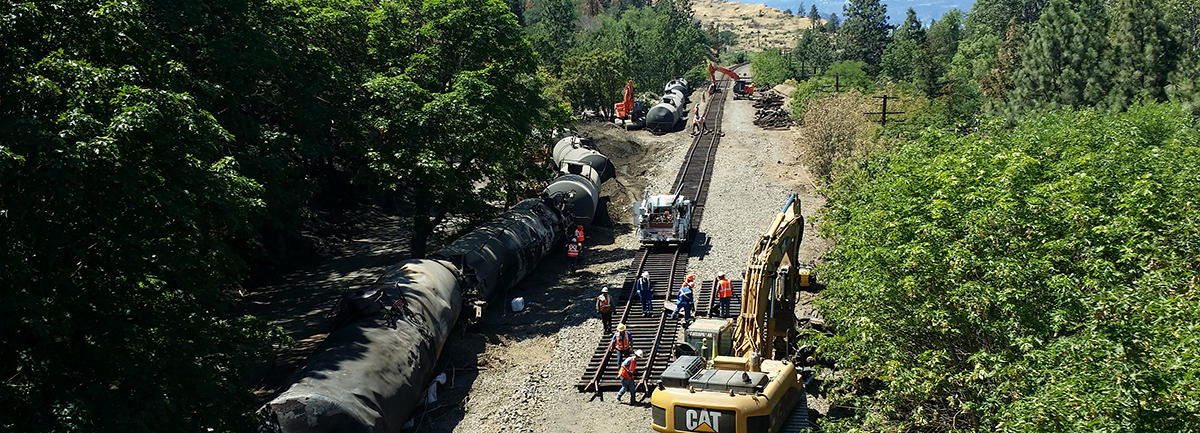For Immediate Release: August 16, 2016
Contacts:
Michael Lang, Conservation Director, Friends of the Columbia Gorge (503) 490-3979
Rail traffic experts issued a report today finding that Union Pacific Railroad’s (UP) proposed rail expansion in the Columbia River Gorge National Scenic Area would result in a massive expansion in the number of trains that could travel through Mosier and would not provide the health and safety benefits touted by the railroad. Due to its location, small improvements to the railroad infrastructure through Mosier could have tremendous ripple effects throughout Wasco County and the Pacific Northwest. The report was produced by Terry Whiteside of Whiteside and Associates based in Billings, MT, and G.W. Fauth & Associates based in Alexandria, VA.
Link to report
According to Union Pacific, 25 to 30 trains per day currently move through Mosier. Union Pacific claims that the four-mile long expansion could increase traffic by 5-7 trains per day, to 30 to 37 trains. In its application, UP even implies that there will be
fewer trains on the line by the utilization of larger trains. Even if Union Pacific utilizes longer trains, it is likely that more trains and substantially more carloads will move through Mosier.
The experts found that, based on estimates by the American Association of Railroads, the current capacity of the Union Pacific rail line should be 30 to 48 trains per day, well within the projected capacity levels of 5 to 7 more trains per day. Based on this analysis, UP has significantly understated the practical capacity of the improved line, which could range from 75 to 100 trains per day, increasing rail traffic by up to 3 trains per
hour.
The City of Mosier is still recovering from the Union Pacific oil train derailment, spill and fire on June 3 that leaked 40,000 gallons of crude oil and contaminated groundwater in the small town. The Federal Railroad Administration (FRA) released a report in June finding that Union Pacific was at fault for the accident because it failed to follow safety and rail inspection requirements.
Unfortunately, according to the FRA, Union Pacific perennially has poor accident statistics when compared with its peers. For example, in 2015 UP experienced 3.17 accidents per 1 million train miles travelled. The 2015 industry average was 2.59 accidents per 1 million train miles travelled. In 2015, there were 11,504 train accidents in the United States. While that number is unacceptably high, if UP operated all of the trains and tracks in the US at its current accident rate there would have been about 2,576 more train accidents. Additionally, a higher percentage of Union Pacific’s 2015 accidents resulted in derailments and significantly more of them were due to faulty tracks, signals, or other equipment maintained by Union Pacific. The industry average of accidents caused by tracks, signals, or equipment is 44% and it is 56% for Union Pacific. This demonstrates the pattern of inadequate maintenance done by Union Pacific.
“Union Pacific caused the Mosier derailment due to its negligence in maintaining its tracks,” said Steve McCoy, Staff Attorney for Friends of the Columbia Gorge. “This is part of a pattern where Union Pacific has a startlingly poor safety record and has consistently lobbied against the FRA’s attempts to improve rail safety. While no railroad is acceptably safe, Union Pacific truly redefines ‘railroad safety.’”
Several oil-by-rail terminal proposals are pending in the Pacific Northwest, including what would be the largest oil by rail terminal in North America, Tesoro’s Vancouver Energy project located on the banks of the Columbia River. With the recent lifting of the U.S. crude oil export ban, many more export terminals could be in the future of the Pacific Northwest. In addition, a coal terminal proposal pending in Longview, WA, would transport 44 million tons of coal per year by rail to ocean going freighters bound for Asian power plants. All of these fossil fuel projects would rely on transporting oil and coal by rail through the Columbia River Gorge National Scenic Area on the Union Pacific and the Burlington Northern Santa Fe rail tracks.
“With likely increases in fossil fuel shipments through the Gorge and Union Pacific’s poor safety record, the Columbia River Gorge and its communities are in real jeopardy,” said McCoy. “We cannot trust the future of communities and our national scenic treasures to Union Pacific.”
The Union Pacific rail expansion proposal is set for a
public hearing before the Wasco County Planning Commission on Sept. 6 at 3 p.m. at the Columbia Gorge Discovery Center in The Dalles. The public is invited to attend and comment on the project.
Read the FRA’s preliminary factual findings report on the Mosier derailment, as well as the agency’s safety analyses of UP and all railroads, respectively. 